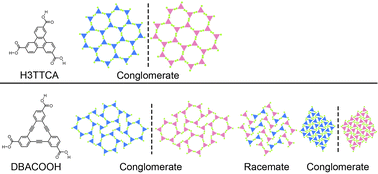Themed collection Nanoarchitectonics Advances: Bridge over Nanotechnology and Materials Science

Mechanochromic aromatic hydrocarbons that bear one simple substituent
Structurally simple aromatic hydrocarbons that possess only one isocyano group show luminescent mechanochromism. The structural isomers of these aromatic hydrocarbons exhibit blue- and red-shifted emission bands upon mechanical stress.

RSC Adv., 2024,14, 7258-7262
https://doi.org/10.1039/D3RA08519H
Nanoarchitectonics of highly dispersed polythiophene on paper for accurate quantitative detection of metal ions
Paper fibers allow the high dispersion of a fluorescent polythiophene chemosensor for the suppression of aggregation-induced quenching, which is applied to the solid-state fluorescent quantitative sensing of metal ions using imaging analysis and pattern recognition techniques.

RSC Adv., 2024,14, 5159-5166
https://doi.org/10.1039/D3RA08429A
Effect of the bulkiness of alkyl ligands on the excited-state dynamics of ZnO nanocrystals
The effect of molecular structures of alkyl groups of alkyl phosphonic ligands on excited-state dynamics of colloidal ZnO nanocrystals was investigated.

RSC Adv., 2024,14, 2796-2803
https://doi.org/10.1039/D3RA05166H
Complexation study of a 1,3-phenylene-bridged cyclic hexa-naphthalene with fullerenes C60 and C70 in solution and 1D-alignment of fullerenes in the crystals
Host–guest interactions between a cyclic hexa-naphthalene and fullerenes were investigated in solution and in the solid state. The complexes in the crystals showed a 1D-array of fullerenes and semiconducting properties.

RSC Adv., 2023,13, 33459-33462
https://doi.org/10.1039/D3RA06526J
Formation of charge-transfer complexes in ionic crystals composed of 1,3-bis(dicyanomethylidene)indan anion and viologens bearing alkyl chains
The relationship between the structure and optical properties of ion pair crystals containing 1,3-bis(dicyanomethilidene)indan anion was clarified.

RSC Adv., 2023,13, 32039-32044
https://doi.org/10.1039/D3RA06782C
Fabrication and photoelectric conversion of densely packed C60–ethylenediamine adduct microparticle films-modified electrode covered with electrochemically deposited polythiophene thin-films
Electrodeposited polythiophene-modified C60–diamine adduct microparticle films generated photocurrent.

RSC Adv., 2023,13, 31244-31251
https://doi.org/10.1039/D3RA05150A
Synthesis of optically active star polymers consisting of helical poly(phenylacetylene) chains by the living polymerization of phenylacetylenes and their chiroptical properties
Star polymers with precisely controlled helical poly(phenylacetylene) arms were synthesized and exhibited chiral amplification compared with the corresponding linear polymers.

RSC Adv., 2023,13, 30978-30984
https://doi.org/10.1039/D3RA05971E
Influence of core size on self-assembled molecular networks composed of C3h-symmetric building blocks through hydrogen bonding interactions: structural features and chirality
The effect of the core size on the structure and chirality of self-assembled molecular networks was investigated using two aromatic carboxylic acid derivatives with frameworks displaying C3h symmetry.

RSC Adv., 2023,13, 29512-29521
https://doi.org/10.1039/D3RA05762C
Janus metallic film with gold and silver luster by electroless deposition of silver using poly(dopamine acrylamide) thin film
A Janus metallic surface was prepared by a one-pot process by reducing silver ions with poly(dopamine acrylamide). Poly(dopamine acrylamide) was synthesized by protection-free controlled RAFT polymerization.

RSC Adv., 2023,13, 28104-28111
https://doi.org/10.1039/D3RA05099H
Encapsulation and thermal properties of composite phase change materials based on cobalt/nitrogen double-doped ZIF-67 derived carbon
The cobalt/nitrogen-doped ZIF-67 derived carbon (CoN-ZIF-Cx) was constructed as the carrier material, and paraffin was used as the phase change core material to construct thermally enhanced shaped composite phase change materials.

RSC Adv., 2023,13, 26907-26917
https://doi.org/10.1039/D3RA04002J
Preparation of spiroborate supramolecular and peapod polymers containing a photoluminescent ruthenium(II) complex
Spiroborate supramolecular and peapod polymers containing ruthenium(II) tris(bipyridyl) complex were prepared, and their optical properties were evaluated.

RSC Adv., 2023,13, 25002-25006
https://doi.org/10.1039/D3RA03940D
Improved supercapacitor performances by adding carbonized C60-based nanospheres to PVA/TEMPO-cellulose hydrogel-based electrolyte
Carbonized C60 nanospheres efficiently improve the mechanical properties and supercapacitor performance when they are added to a poly(vinyl alcohol)/TEMPO-cellulose hydrogel-based electrolyte.

RSC Adv., 2023,13, 21502-21509
https://doi.org/10.1039/D3RA03349J
How similar is the antibacterial activity of silver nanoparticles coated with different capping agents?
Nanosilver antibacterial activity is governed by a balance between the nanosilver stability and their ability to release/dope Ag+ to solution.

RSC Adv., 2023,13, 10542-10555
https://doi.org/10.1039/D3RA00917C
Biodegradable porous polymeric drug as a drug delivery system: alleviation of doxorubicin-induced cardiotoxicity via passive targeted release
Alleviation of doxorubicin-induced cardiotoxicity by a biodegradable porous organic polymer drug delivery system via passive targeted release.

RSC Adv., 2023,13, 5444-5456
https://doi.org/10.1039/D2RA07410A
About this collection
Expanding and going beyond the field of nanotechnology, a new concept of nanoarchitectonics has been proposed. Nanoarchitectonics aims to construct materials with precise structures that achieve high performance from nanoscale units such as atoms, molecules, and nanomaterials. Beyond the well-known strategies of self-assembly and related strategies, nanoarchitectonics aims to construct material structures containing more asymmetric and hierarchical motifs from multiple components. Nanoarchitectonics bridges the missing link between nanotechnology and materials science. The impact of nanoarchitectonics goes beyond fabricating such structures to developing nanostructured materials useful for sensing, catalysis, energy, environmental, and biomedical applications.
Such attempts have in fact been widely studied but should be reconstructed under the name of nanoarchitectonics as a link between nanotechnology and materials science. This special issue will encompass the development of various functions enabled by this bottom-up approach to structure development. Examples of possible targets include:
1) Supramolecular assemblies and self-assemblies
2) Coordination nanostructures such as MOFs
3) Hybrids, composites, and blends that exhibit nanostructures and functions
4) Various other functional materials that include nanostructures
5) Sensing, catalytic, energy, environmental, biomedical and other applications
The aim of this collection is not only to describe conventional approaches, but to also describe how the research relates to nanoarchitectonics.
This collection is Guest Edited by Professor Katsuhiko Ariga (National Institute for Materials Science & The University of Tokyo, Japan), Professor Hiromitsu Maeda (Ritsumeikan University, Japan), Dr Stéphane Baudron (Université de Strasbourg-CNRS, France), and Professor Yulan Chen (Jilin University, China).